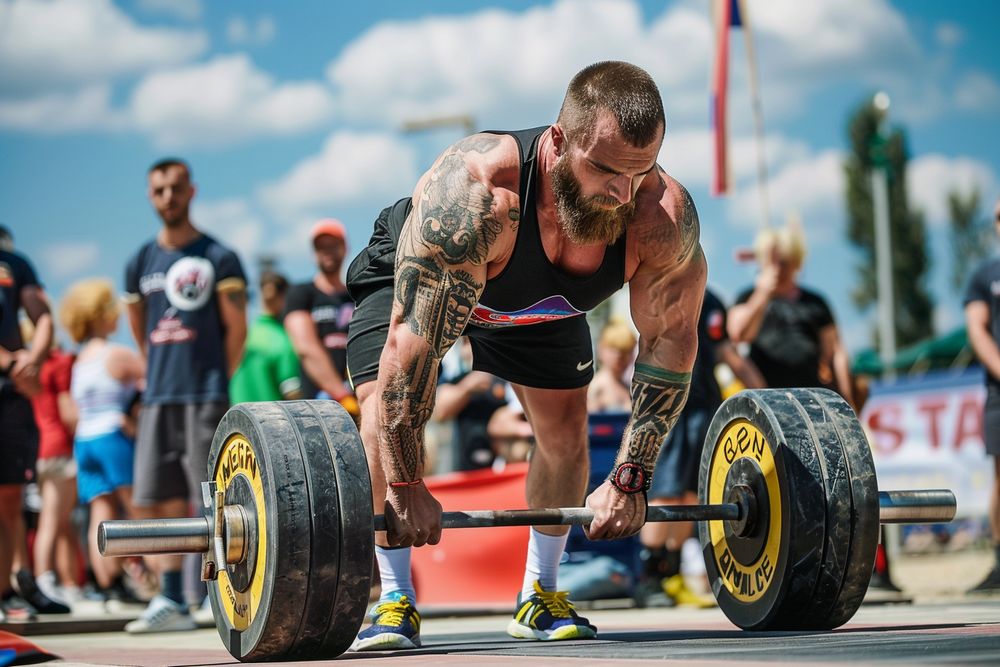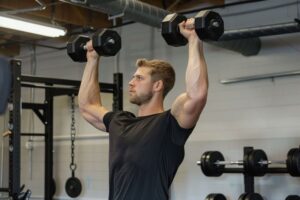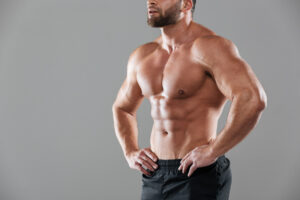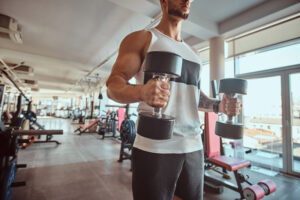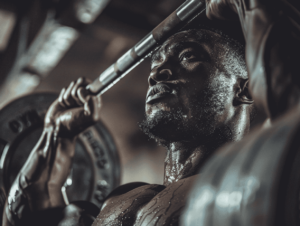Deadlifting is a powerhouse exercise that can transform your fitness journey. It’s not just about picking up heavy weights; it’s about building total-body strength, improving posture, and boosting your athletic performance.
Think of deadlifting as the foundation of your strength training house. Build it right, and everything else becomes stronger. Skimp on the details, and you might find your fitness goals crumbling.
Ready to learn how to deadlift like a pro? Let’s dive in and unlock the secrets to mastering this game-changing exercise.
This article is brought to you by Brutal Force – your ultimate source for safe, legal alternatives to steroids and SARMs. With scientifically-backed formulas designed to enhance muscle growth, strength, and performance, Brutal Force helps you achieve your bodybuilding goals without the harmful side effects. Discover a range of products that cater to your bulking, cutting, and overall fitness needs. Experience transformative results with Brutal Force today.
Understanding the Basics of Deadlifting
What is a Deadlift?
At its core, a deadlift is a simple yet powerful movement. You’re literally lifting “dead” weight off the ground – no momentum, no bounce, just pure strength.
Picture this: you walk up to a loaded barbell on the floor. You bend down, grab it, and stand up straight. That’s a deadlift in a nutshell.
But don’t let its simplicity fool you. Deadlifting with proper form engages nearly every muscle in your body, from your legs and back to your core and arms. It’s a full-body workout wrapped up in one mighty move.
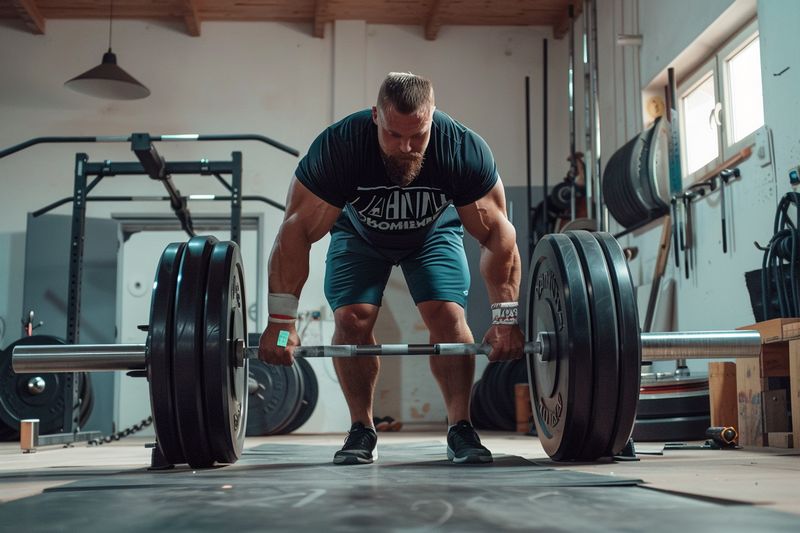
Types of Deadlifts
Just like there’s more than one way to brew a perfect cup of coffee, there’s more than one way to deadlift. The two main types you’ll encounter are the conventional deadlift and the sumo deadlift.
The conventional deadlift is the classic version. Your feet are about hip-width apart, and you grip the bar just outside your legs. It’s a favorite among powerlifters and a true test of overall strength.
Now, meet the sumo deadlift. Here, you spread your feet wider, sometimes twice shoulder-width. Your hands grip the bar between your legs. This style often feels more comfortable for those with longer limbs or less flexible hips.
Both styles have their merits, and the best choice often comes down to your body type and personal preference. Don’t be afraid to experiment and find your deadlift sweet spot.
Preparing for Your Deadlift
Setting Up Your Equipment
Before you start channeling your inner strongman, let’s talk gear. The star of the show? A loaded barbell.
For beginners, start with a standard 45-pound Olympic barbell. As you progress, you’ll add weight plates to increase the challenge. Make sure you have a variety of plates on hand to fine-tune your lifts.
Pro tip: Invest in some lifting chalk. It’ll improve your grip and help you maintain control throughout the lift. Just don’t go overboard – your gym’s cleaning crew will thank you.
Warm-up Exercises
Jumping into a deadlift cold is like trying to run a marathon without tying your shoelaces. It’s a recipe for disaster. A proper warm-up primes your body for the intense lower body exercise to come.
Start with some light cardio to get your blood flowing. A 5-minute jog or jump rope session works wonders.
Next, target the muscles you’ll be using. Try some bodyweight squats, leg swings, and hip circles. Don’t forget your upper body – arm circles and light rows can help prepare your back and shoulders.
Finally, practice the deadlift movement with just the empty bar. This rehearsal helps groove the proper pattern into your muscle memory.
Mastering Proper Deadlift Form
Starting Position
The foundation of a great deadlift is a rock-solid starting position. Think of it as the launchpad for your lift – get it right, and you’re halfway to success.
Begin by standing with your feet hip-width apart. The barbell should be over your midfoot, almost touching your shins. This is your home base.
Hinge at your hips, pushing your butt back as if you’re trying to touch a wall behind you. Keep your back straight and chest up as you lower yourself to the bar.
Grab the bar with your hands just outside your legs. Your arms should be straight, not bent at the elbows. Picture yourself as a coiled spring, ready to explode upward.
Take a deep breath, brace your core, and prepare for liftoff. Remember, a solid starting position sets the stage for a powerful, safe lift.
Grip Techniques
Your grip can make or break your deadlift. Let’s explore the main contenders in the grip game.
First up, the overhand grip. Both palms face your body. It’s great for beginners and lighter weights, but can be challenging as the bar gets heavier.
Next, we have the mixed grip. One hand over, one under. This prevents the bar from rolling and allows for heavier lifts. Just remember to alternate your under-hand to avoid imbalances.
For the grip aficionados, there’s the hook grip. Thumb under, fingers over. It’s secure but can be uncomfortable at first. Many powerlifters swear by it for max-effort lifts.
Maintaining a Neutral Spine
Picture your spine as a steel rod – strong, straight, and unyielding. That’s the image you want to maintain throughout your deadlift.
A neutral spine is your ticket to a safe, effective lift. It distributes the load evenly and protects your back from injury.
To find neutral, stand tall and place your hands on your hips. Tilt your pelvis forward and back until you find the middle ground – not arched, not rounded, just right.
As you set up for the lift, maintain this position. It might feel strange at first, especially if you’re used to rounding your back. But trust the process – your spine will thank you.
Hip Hinge and Leg Drive
The hip hinge is the secret sauce of a great deadlift. It’s not a squat – it’s a hinge. Think of your hips as a door hinge, pivoting back and forth.
As you lower to grab the bar, push your hips back, keeping your back straight. Your shins should stay relatively vertical, with your weight in your heels.
When you lift, drive through your heels. Imagine you’re pushing the earth away from you. Your hips and shoulders should rise at the same rate.
At the top of the movement, squeeze your glutes and push your hips forward. This completes the hinge and locks out the lift.
Remember, it’s a hip hinge, not a back lift. Let your powerful leg muscles do the work, and your back will stay happy and healthy.
Engaging the Core
Your core is the unsung hero of the deadlift. It’s the bridge between your upper and lower body, providing stability and power transfer.
Before you lift, take a deep breath into your belly. Brace your core as if you’re about to take a punch. This creates intra-abdominal pressure, supporting your spine.
Maintain this core tension throughout the lift. It’s not just about having a six-pack – it’s about creating a solid foundation for heavy lifting.
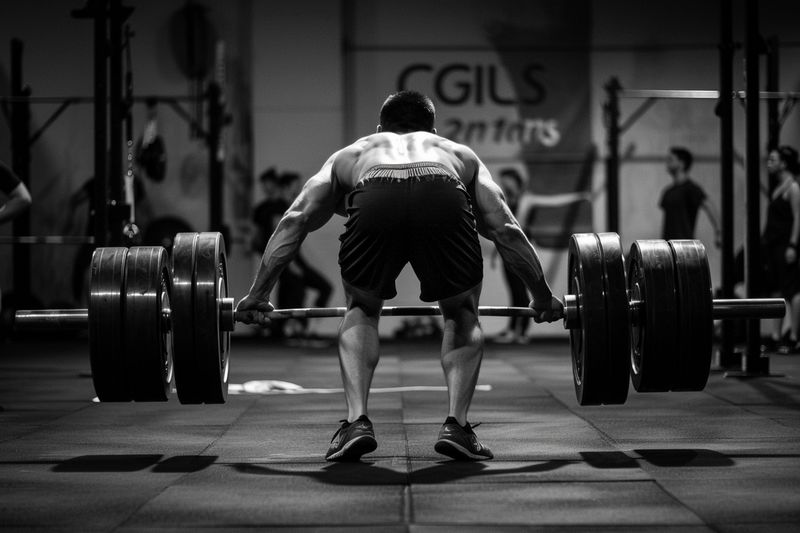
The Deadlift Movement
Initiating the Lift
The moment of truth has arrived. You’re set up, your grip is solid, and you’re ready to pull. But hold on – don’t yank that bar off the floor just yet.
Start by creating tension in your body. Pull the slack out of the bar, feeling its weight before it even leaves the ground. This primes your muscles and ensures a smooth, controlled lift.
As the bar passes your shins, keep it close to your body. Think of dragging it up your legs. This maintains your balance and leverages your strength effectively.
Remember, it’s not about jerking the weight up. It’s a smooth, powerful drive from the floor to a standing position. Patience and control are your allies here.
The Ascent
As you lift the weight, think “push” rather than “pull”. You’re not pulling the bar up – you’re pushing the ground away with your feet.
Keep the bar close to your body throughout the movement. It should nearly graze your shins and thighs as it travels upward. This close bar path is crucial for maintaining leverage and balance.
Your hips and shoulders should rise at the same rate. If your hips shoot up first, you’ll end up lifting with your back – a one-way ticket to Injury Town.
As the bar passes your knees, drive your hips forward. This powerful hip extension is what gives the deadlift its reputation as a posterior chain builder.
Lockout Position
The lockout is your moment of triumph. Stand tall, with your hips fully extended and shoulders back. But don’t overdo it – we’re not going for a backbend here.
Squeeze your glutes at the top of the lift. This ensures full hip extension and engages your powerful hip muscles.
Your shoulder blades should be in a neutral position – not pinched back, not rounded forward. Think “proud chest” rather than exaggerated arch.
The Descent
What goes up must come down, but don’t just drop the weight. The descent is just as important as the lift itself.
Start by hinging at your hips, pushing your butt back as if you’re trying to touch a wall behind you. Keep the bar close to your body as you lower it.
Maintain tension in your core and back. Avoid losing tension or rounding your back as you set the weight down. It’s tempting to relax at the end of a heavy lift, but stay focused until the bar is back on the ground.
Control the descent, but don’t make it too slow. A controlled drop is more efficient than a super-slow lowering, especially when working with heavier weights.
Common Deadlift Variations
Romanian Deadlift
The Romanian deadlift (RDL) is like the deadlift’s sophisticated cousin. It starts from the top and focuses on the descent, making it a killer hamstring and glute exercise.
Begin standing with the bar at hip level. Hinge at your hips, pushing them back while keeping your legs nearly straight (soft knees, not locked). Lower the bar along your legs until you feel a stretch in your hamstrings.
The key difference? You don’t touch the ground. Stop when the bar is at mid-shin level, then drive your hips forward to stand up.
RDLs are fantastic for developing hamstring flexibility and strength. They’re also easier on the lower back than conventional deadlifts, making them a great option for those with back concerns.
Sumo Deadlift
The sumo deadlift is named after the wide stance of sumo wrestlers. It’s not just a style choice – it can be a game-changer for your lifting.
The only difference from conventional is your setup. Take a wide stance, about 1.5 to 2 times shoulder width. Your toes should point out at about 45 degrees.
Grip the bar inside your legs, arms straight down from your shoulders. This position reduces the distance the bar travels, making it easier for some lifters to maintain a neutral spine.
Sumo deadlifts tend to be easier on the lower back and put more emphasis on the quads and inner thighs. They’re worth trying if conventional deadlifts feel awkward or cause back discomfort.
Trap Bar Deadlift
Enter the trap bar deadlift, a hybrid between a squat and a conventional deadlift. The trap bar, shaped like a hexagon, allows you to stand inside it rather than behind the bar.
This variation puts you in a more upright position, reducing stress on the lower back. It’s a great option for beginners or those returning from a back injury.
The movement is similar to a conventional deadlift, but the bar travels straight up and down, in line with your center of gravity. This makes balancing easier and allows for heavier lifts for many people.
Don’t be fooled by its friendlier reputation – trap bar deadlifts can still pack a punch. They’re excellent for building overall strength and power, especially in the quads and upper back.
Muscles Worked in Deadlifts
Primary Muscle Groups
Deadlifts are a full-body affair, but some muscles take the spotlight. Let’s break down the star players in this strength-building symphony.
First up, the posterior chain. This group includes your hamstrings, glutes, and lower back muscles. They’re the powerhouse behind the hip hinge movement.
Your back muscles, particularly the erector spinae, work overtime to keep your spine neutral. They’re the unsung heroes preventing your back from rounding under heavy loads.
Don’t forget about your glutes – the largest muscle in your body. They’re crucial for that powerful hip extension at the top of the lift.
Your quadriceps join the party too, helping to extend your knees as you stand up with the weight. They’re especially active in sumo and trap bar variations.
Secondary Muscle Groups
While not the main event, these supporting players are crucial to a successful deadlift. Your upper body gets more of a workout than you might think.
Your latissimus dorsi, or lats, play a key role in keeping the bar close to your body. They’re like guide rails for the bar’s path.
Forearms and grip muscles work hard to maintain your hold on the bar. A deadlift session can leave your hands feeling like you’ve been rock climbing all day.
Core muscles, including your abs and obliques, engage to stabilize your spine. They’re the silent guardians of your lower back.
Even your calf muscles and upper traps get in on the action, contributing to overall stability and the final lockout. Deadlifts truly are a head-to-toe exercise!
Progressing Your Deadlift
Starting with Light Weights
The journey of a thousand pounds begins with a single plate. Starting light is crucial to mastering the deadlift and exercising properly.
Begin with just the bar or even a broomstick. This allows you to groove the proper movement pattern without the stress of heavy weights.
Focus on perfecting your form. Each rep should feel smooth and controlled. If you’re struggling with the movement, drop the weight – your ego will recover, but your back might not.
Gradually Increasing Weight
Once you’ve nailed the form with light weights, it’s time to start challenging yourself. But remember, Rome wasn’t built in a day, and neither is a impressive deadlift.
Increase the weight gradually – 5 to 10 pounds per week is a good rule of thumb. This steady progression allows your body to adapt and grow stronger without overwhelming it.
Listen to your body. Some weeks you’ll feel like a superhero, others like a mere mortal. Adjust your lifts accordingly, and don’t be afraid to take a step back if needed.
As you move to heavier weights, pay extra attention to your form. It’s easy to let technique slip when you’re pushing your limits. If your form breaks down, it’s time to drop the weight and rebuild.
Improving Grip Strength
Your deadlift is only as strong as your grip. As the weights get heavier, your hands need to keep up. A strong grip isn’t just about deadlifting – it carries over to nearly every aspect of strength training and daily life.
One simple way to improve grip strength is to hold your final deadlift rep at the top for as long as possible. This “static hold” challenges your grip and builds endurance.
Farmer’s walks are another excellent grip builder. Simply grab a heavy dumbbell in each hand and walk for distance or time. It’s simple, but brutally effective.
Don’t underestimate the power of pull-ups and hanging exercises. Try hanging from a pull-up bar for time, gradually increasing your hang duration.
For a more targeted approach, invest in a grip strengthener or hand gripper. These portable devices allow you to train your grip anywhere, anytime.
Lastly, consider ditching the straps for your lighter sets. While straps have their place in training, relying on them too much can hinder grip development. Save them for your heaviest lifts and PR attempts.
Remember, grip strength takes time to develop. Be patient and consistent with your training, and soon you’ll have a vice-like grip that can handle any deadlift challenge you throw at it.
Frequently Asked Questions About Deadlift Technique
How to do a deadlift for beginners?
To deadlift properly as a beginner: 1. Stand with feet hip-width apart, toes facing forward. 2. Position the bar over your mid foot. 3. Hinge at the hips to grip the bar with hands just outside your legs. 4. Lower your hips, keeping your chest up and back straight. 5. Take a deep breath, brace your core, and lift the bar by pushing through your feet and extending your hips and knees. 6. Stand tall at the top, then hinge forward to lower the bar back down.
Remember, start with light weights to perfect your form before attempting to lift heavier weights.
What are the 3 keys to proper deadlift technique?
The three key elements to correct deadlift form are: 1. Proper Setup: Bar over mid foot, shoulders slightly ahead of the bar, hips high. 2. Maintaining a Neutral Spine: Keep your back straight throughout the entire lift. 3. Engaging the Lats: Pull the slack out of the bar and engage your lats to keep the bar close to your body during the lift.
Focusing on these points will help you deadlift safely and effectively.
What is a good deadlift weight for a beginner?
A good starting weight varies based on individual strength and fitness levels. Many beginners start with just the barbell (45 lbs/20 kg) to practice form.
Once comfortable, gradually add weight. A general guideline might be: – Men: 50-125% of body weight – Women: 50-75% of body weight Remember, it’s crucial to prioritize form over weight to avoid risk injury.
What is the proper deadlift form grip?
There are three main grip styles for deadlifts: 1. Double overhand grip: Both palms facing your body. Good for beginners but may limit weight as you progress. 2. Mixed grip: One hand over, one under. Allows lifting heavier weights but can cause imbalances. 3. Hook grip: Thumb wrapped under fingers. Secure but can be uncomfortable.
Start with double overhand. As weights increase, experiment to find what works best for you while maintaining proper position.
Should you put the bar down between deadlifts?
Yes, it’s generally recommended to put the bar down between reps, especially for beginners. This approach: 1. Ensures proper form for each rep 2. Reduces fatigue and maintains technique 3. Eliminates using stretch reflex, making each rep a true deadlift
However, some advanced lifters may perform touch-and-go deadlifts, where the bar barely touches the ground before the next rep. This technique requires excellent form and control.
Conclusion: Embrace the Deadlift Journey
Mastering the deadlift is a journey, not a destination. It’s about consistent practice, gradual progression, and unwavering attention to form.
Remember, every great lifter started somewhere. Be patient with yourself, celebrate small victories, and never compromise on safety. With time and dedication, you’ll not only learn how to deadlift – you’ll thrive at it.
So, grab that bar, hinge those hips, and lift with confidence. Your stronger, more powerful self is just a deadlift away. Now go out there and make every rep count!
Looking to Enhance Your Workout?
Transform your fitness journey with Brutal Force. Our safe, legal alternatives to steroids and SARMs boost muscle growth, strength, and performance without the side effects. Ready to take your training to the next level? Explore Brutal Force supplements today and start seeing real results.



